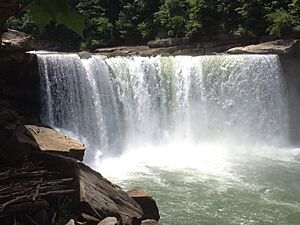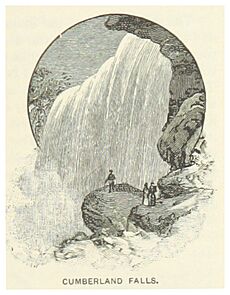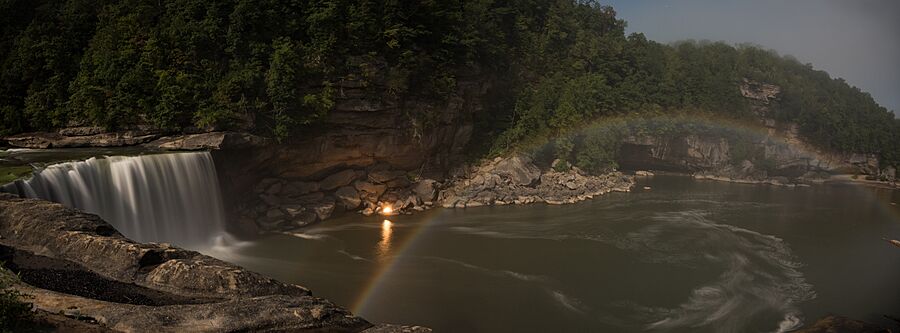Cumberland Falls facts for kids
Quick facts for kids Cumberland Falls |
|
|---|---|

Cumberland Falls, viewed from downstream
|
|
| Lua error in Module:Infobox_mapframe at line 185: attempt to index field 'wikibase' (a nil value). | |
| Location | Cumberland Falls State Resort Park, McCreary County & Whitley County, Kentucky, United States |
| Coordinates | 36°50′17″N 84°20′40″W / 36.83801°N 84.34444°W |
| Type | Block |
| Total height | 69 ft (21 m) |
| Number of drops | 1 |
| Watercourse | Cumberland River |
Cumberland Falls is a beautiful waterfall on the Cumberland River in southeastern Kentucky. People sometimes call it the Little Niagara or the Niagara of the South because it's so impressive. It sits right on the border between McCreary and Whitley counties.
This amazing waterfall is the main attraction of Cumberland Falls State Resort Park. It's also part of a special protected river system managed by the Office of Kentucky Nature Preserves. Scientists believe the falls formed over a very long time. It moved slowly upstream from its original spot due to the river's power.
Long ago, different groups of Native Americans lived near the falls. Later, the land was owned by several private individuals. Eventually, in 1933, the falls and the land around it were given to the state of Kentucky to become a park. One of the most exciting things about Cumberland Falls is that you can often see a rare "moonbow" here!
Contents
History of Cumberland Falls
How the Falls Formed
Scientists think Cumberland Falls started at a rocky cliff called the Pottsville Escarpment. This was near a town called Burnside, Kentucky. Over thousands of years, the waterfall slowly moved upstream to where it is today. That's about 45 miles (72 km) (72 km) away!
As the falls moved, it carved out the deep Cumberland River gorge. In some places, this gorge is up to 400 feet (120 m) (122 m) deep! The falls used to be taller and had more water flowing over it. This is because two big rivers, the Laurel River and the Rockcastle River, now join the Cumberland River after the falls.
The rocks under the falls are always eroding, or wearing away. This means the falls will keep moving upstream and getting shorter. Eventually, it will disappear, and the river will become smooth again. But don't worry, that will take a very, very long time!
Early History
The area around Cumberland Falls has been home to Native Americans for as long as 10,000 years. By the 1650s, groups like the Shawnee, Cherokee, Chickasaw, and Creek peoples had visited the area. Both Cumberland Falls and the nearby Eagle Falls were considered very special and sacred by many of these groups.
Modern History and the Park
In 1750, an explorer named Thomas Walker rediscovered the falls. He named it after the Duke of Cumberland and Strathearn. The first people to officially own the land around the falls were Matthew Walton and Adam Shepard in 1800. They were engineers who had served with George Washington.
The first family to live permanently at Cumberland Falls was Lewis Renfro and his wife Mary. They built a cabin there in 1850. This cabin was even used as a hospital during the American Civil War.
Later, in 1875, Socrates Owens bought the falls and 400 acres of land. He built the Cumberland Hotel there. His family continued to run the hotel after he passed away. In 1902, Henry Brunson bought the property and managed it with his daughters until 1931.
In 1927, the Kiwanis Club helped build a new trail to the falls from a nearby town. About 200 workers spent nine weeks building it. Even with the new trail, it was still hard to reach the falls in the late 1920s. People said the roads were so rough that only horses could easily travel them.
Around this time, there were plans to build a hydroelectric power station upstream. This would have changed the river and the falls. But a group called the Cumberland Falls Preservation Association worked to save the falls. They convinced a wealthy businessman named T. Coleman du Pont to buy the land. He made sure it could never be used for electricity.
After du Pont passed away in 1930, his family decided to donate 539 acres (218 ha) (218 hectares) of land to the state of Kentucky. The Kentucky government accepted the gift, even though the governor at the time tried to stop it. Cumberland Falls State Resort Park officially opened on September 7, 1931.
In the 1950s, there were more plans for hydroelectric power near the falls. But again, the Preservation Association helped stop them.
Sometimes, people try risky stunts at the falls. In 2016, two men went over Cumberland Falls in kayaks.
The Moonbow
One of the most special things about Cumberland Falls is the chance to see a "moonbow." This is like a rainbow, but it's made by the light of the full moon instead of the sun! It happens on clear nights when the moon is full or almost full.
The moonbow forms because of the mist from the waterfall. The steep walls of the gorge help keep the mist from blowing away. Also, the wide gorge allows a lot of moonlight to reach the mist.
Cumberland Falls is the only place in the Western Hemisphere where moonbows are known to appear regularly. The Kentucky Department of Parks even publishes a schedule so visitors know when they might see one!
Whether you can see a moonbow depends on the water level. If the water is too low, there might not be enough mist. But if there's a strong wind blowing downstream, it can create more mist and make a moonbow more likely to appear.
Facts and Figures
| Year | Average |
|---|---|
| 1927 | 5,196 ft3/s |
| 1994 | 5,143 ft3/s |
| 1974 | 5,117 ft3/s |
| 2011 | 4,974 ft3/s |
| 1973 | 4,684 ft3/s |
| Year | Average |
| 1981 | 1,657 ft3/s |
| 1931 | 1,622 ft3/s |
| 1966 | 1,499 ft3/s |
| 1941 | 1,423 ft3/s |
| 1988 | 1,324 ft3/s |
Cumberland Falls is about 68 feet (21 m) high and 125 feet (38 m) wide. The water flows over a strong sandstone rock bed. It's the second largest waterfall east of the Rocky Mountains. It's also the largest waterfall in the Eastern United States by water volume, south of Niagara Falls. The falls divides the Cumberland River into two parts: the Upper section and the Lower section.
Water Flow
The water that flows over Cumberland Falls comes from a huge area of 1,977 square miles (5,120 km2) (5,120 km2). The United States Geological Survey has collected data on the water flow since 1908.
The most water flowed over the falls in 1927, with an average of 5,196 cubic feet per second (ft3/s). The least amount of water flowed in 1988, during a drought, with an average of 1,324 ft3/s. The highest amount of water ever recorded was on January 28, 1918, when 59,600 ft3/s rushed over the falls!
Cumberland Falls in Pop Culture
Cumberland Falls has appeared in movies, books, and even video games!
- Film
- The Kentuckian (1955): A movie starring Burt Lancaster, filmed right at the falls.
- Raintree County (1957): This film, starring Montgomery Clift and Elizabeth Taylor, also filmed scenes at the falls.
- Fire Down Below (1997): A movie starring Steven Seagal that includes a cool flyover shot of the falls.
- Literature
- The popular poem "Cumberland Falls" by Kentucky Poet Laureate Silas House uses the falls as a setting and a symbol. The Academy of American Poets selected this poem.
- Video Games
- Red Dead Redemption 2: This video game features a waterfall that looks a lot like Cumberland Falls, and it's even called Cumberland Falls in the game!
See also
 In Spanish: Cataratas Cumberland para niños
In Spanish: Cataratas Cumberland para niños




